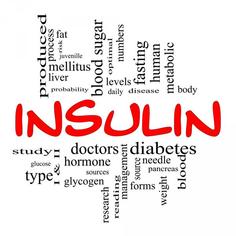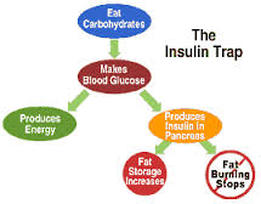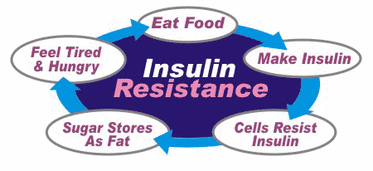
Learn how to use this important hormone
to improve your health, and more importantly,
optimize your GAINS!
to improve your health, and more importantly,
optimize your GAINS!
By Craven
Insulin. We all know what this is, right?
Okay, good.
Wait, you don't?
Well that's no problem, because you're not the only one. In fact, if you ask anyone what insulin is, you'll have a hard time finding someone who knows what this vital hormone exactly is, and more importantly, how it's used in your body.
I'm sure you've heard people talking about insulin before, throwing around expressions like "get your insulin up with your post-workout shake, bro!", without ever knowing precisely why.
That's not an entirely wrong answer, but also not entirely correct. Let's take a look at what insulin is, exactly.
From a biological standpoint, insulin is purely anabolic( Anabolic, there's another fun word everyone likes to think they know). The accurate definition of anabolic means to build stuff, and that stuff is organic tissue in your body. This means everything from muscle mass, fat cells, damaged/sick cells, and glycogen. Insulin doesn't directly do the building, as everyone likes to think, but rather signals other cells that there is raw material present in the body and it needs to utilize it by absorption.
Simple, right? Lets continue.
There's a lot of different factors that can dictate how your body wants to use the raw material (glucose from a meal), but if there's an excess amount of raw material than the cell needs, it's going to store it directly as fat(probably don't want this), glycogen(we want this), or non-functional muscle tissue(just stores protein).
Let's move things along, now.
Insulin has a catch-22 involved with it, in case you haven't gathered that yet. While it's anabolic (builds tissue), it's also anti-catabolic (keeps tissue from being broken down). That's great! But not so fast.
While it does preserve muscle tissue from being wasted, it's at the expense of your body's ability to burn fat.
Insulin has a inverse relationship with hormones that allow your body to burn fat, and it looks something like this:
High Insulin=Low/No fat burning
Low Insulin=High/constant fat burning
What actually activates the insulin response?
CARBOHYDRATES. and to a lesser expense, protein. Fat almost has no effect on insulin levels.
If you "lift, bro" you've probably heard to have your 7-9 meals, all with a heaping serving of "clean carbs" at each of those meals. This is where you get a lot of collateral damage happening.
When you're constantly putting carbs in your body, you increase the glucose in your blood stream, signaling the release of insulin. That's how it's supposed to be, but when your glycogen (cells that store energy for mechanical work in muscles) are all ready saturated from the constant flux of carbs you've ingested from your previous meal only a few short hours prior, your body must do something with the excess raw material.
Where does this excess material go? Fat cells. And unlike glycogen and muscle cells, fat cells have an infinite ability to grow. This is demonstrated quite well by the shoppers at Wal-Mart stores across the country. Step inside and take a gander at the shear girth roaming the aisles.
Insulin. We all know what this is, right?
Okay, good.
Wait, you don't?
Well that's no problem, because you're not the only one. In fact, if you ask anyone what insulin is, you'll have a hard time finding someone who knows what this vital hormone exactly is, and more importantly, how it's used in your body.
I'm sure you've heard people talking about insulin before, throwing around expressions like "get your insulin up with your post-workout shake, bro!", without ever knowing precisely why.
That's not an entirely wrong answer, but also not entirely correct. Let's take a look at what insulin is, exactly.
From a biological standpoint, insulin is purely anabolic( Anabolic, there's another fun word everyone likes to think they know). The accurate definition of anabolic means to build stuff, and that stuff is organic tissue in your body. This means everything from muscle mass, fat cells, damaged/sick cells, and glycogen. Insulin doesn't directly do the building, as everyone likes to think, but rather signals other cells that there is raw material present in the body and it needs to utilize it by absorption.
Simple, right? Lets continue.
There's a lot of different factors that can dictate how your body wants to use the raw material (glucose from a meal), but if there's an excess amount of raw material than the cell needs, it's going to store it directly as fat(probably don't want this), glycogen(we want this), or non-functional muscle tissue(just stores protein).
Let's move things along, now.
Insulin has a catch-22 involved with it, in case you haven't gathered that yet. While it's anabolic (builds tissue), it's also anti-catabolic (keeps tissue from being broken down). That's great! But not so fast.
While it does preserve muscle tissue from being wasted, it's at the expense of your body's ability to burn fat.
Insulin has a inverse relationship with hormones that allow your body to burn fat, and it looks something like this:
High Insulin=Low/No fat burning
Low Insulin=High/constant fat burning
What actually activates the insulin response?
CARBOHYDRATES. and to a lesser expense, protein. Fat almost has no effect on insulin levels.
If you "lift, bro" you've probably heard to have your 7-9 meals, all with a heaping serving of "clean carbs" at each of those meals. This is where you get a lot of collateral damage happening.
When you're constantly putting carbs in your body, you increase the glucose in your blood stream, signaling the release of insulin. That's how it's supposed to be, but when your glycogen (cells that store energy for mechanical work in muscles) are all ready saturated from the constant flux of carbs you've ingested from your previous meal only a few short hours prior, your body must do something with the excess raw material.
Where does this excess material go? Fat cells. And unlike glycogen and muscle cells, fat cells have an infinite ability to grow. This is demonstrated quite well by the shoppers at Wal-Mart stores across the country. Step inside and take a gander at the shear girth roaming the aisles.
Your body also becomes resistant to the release of constantly having to release insulin, keeping blood-sugar levels elevated (not a good thing, this is how diabetes begins) and essentially becomes numb to insulin.
Let's condense some of this and make sense of the information.
- Increased blood-glucose initiates response of insulin, clearing the glucose from the bloodstream
- Insulin signals cells to utilize raw material to be utilized for tissue repair and growth
- Fat burning is highest when insulin is not released
- It's useful to elevate insulin levels at certain times(post workout) and detrimental at others
- Insulin SENSITIVITY is a good thing, while insulin RESISTIVITY is not
Having a healthy insulin sensitivity is something everyone should aim to achieve, as this is what allows your body to signal the response and feedback mechanisms involved with lowering elevated blood sugar and keeping your energy levels regulated. As mentioned above, the problem with being so insulin sensitive is your body does not discriminate when it comes to using raw material. Not without some outside forces acting on it, anyway.
What kind of outside forces?
This is where weight training becomes EXTREMELY beneficial. I'll repeat this. Weight training becomes extremely beneficial.
To keep it short, I'll just say exercise, and especially lifting weights, directions raw materials into tissues that take priority, such as muscle cells and replenishing glycogen, if you're lifting weights!
While protein is essential for building and maintaining muscle, it's the carbohydrates that are responsible for increasing muscle size and improving strength!
This doesn't mean lifting weights is a perfect excuse to load up on cookies and ice cream, even if your diet is flexible. I've seen this in person, and trust me, it ain't pretty.
Lifting weights helps tremendously, but as I mentioned, if you're on a plan that requires you to eat 7 meals a day, with let's say 50 grams of carbs per meal, you're looking at 3500 grams of carbs per day! And if you don't know macro and portion sizes, 50 grams isn't very much. See how this can escalate quickly?
Shovel down 3500 grams of carbs long enough and sure, you'll gain some muscle, but it's going to be hidden under a very visible layer of fat. Take my word for it, it happened to me, all thanks to a lack of knowledge about insulin.
Here's a quick tip on utilizing insulin to to it's full potential to maximize your muscle and fat loss gains:
I'll leave it at that for now, there's still a lot more I want to discuss, and I will, but i just wanted to lay some groundwork for what I'm ultimately trying to compile as a complete nutrition/dietary model.
Just remember this: Carbs are not the enemy. In fact, they're essential, more so for some than others, if you're looking to build your body. What you must do is make an conscious effort to know WHAT and WHEN to eat in order to maximize your insulin sensitivity and prevent any insulin resistance down the line.
What kind of outside forces?
This is where weight training becomes EXTREMELY beneficial. I'll repeat this. Weight training becomes extremely beneficial.
To keep it short, I'll just say exercise, and especially lifting weights, directions raw materials into tissues that take priority, such as muscle cells and replenishing glycogen, if you're lifting weights!
While protein is essential for building and maintaining muscle, it's the carbohydrates that are responsible for increasing muscle size and improving strength!
This doesn't mean lifting weights is a perfect excuse to load up on cookies and ice cream, even if your diet is flexible. I've seen this in person, and trust me, it ain't pretty.
Lifting weights helps tremendously, but as I mentioned, if you're on a plan that requires you to eat 7 meals a day, with let's say 50 grams of carbs per meal, you're looking at 3500 grams of carbs per day! And if you don't know macro and portion sizes, 50 grams isn't very much. See how this can escalate quickly?
Shovel down 3500 grams of carbs long enough and sure, you'll gain some muscle, but it's going to be hidden under a very visible layer of fat. Take my word for it, it happened to me, all thanks to a lack of knowledge about insulin.
Here's a quick tip on utilizing insulin to to it's full potential to maximize your muscle and fat loss gains:
- If you insist on eating carbohydrates early in the day, consume them in a mixed meal with good amounts of protein and fat. This reduces the insulin response needed to clear blood glucose.
- During and After your workout is the best time to consume complex (fast acting, sugars) to replenish glycogen stores that were used/being used during training and helps to reduce muscle protein breakdown that occurs from training.
- If you're training regularly with good amounts of intensity, eat your carbs later in the evening! Your body's sensitivity to insulin decreases throughout the day, meaning less raw material will be driven into both fat and muscle cells. But if you've weight trained that day, your body's natural response will be to partition carbohydrates where they're needed most (muscle cells and glycogen) If you haven't done so, check out my article on the benefits of consuming carbs in the evening here.
- Track your macronutrients! If you know how many grams of carbs (and other macros) you're consuming per mea, you're more incline to make smarter decisions with your food choices and also enjoy your food a lot more and reduce your stress! My take on how to do this with flexible dieting can be found here.
I'll leave it at that for now, there's still a lot more I want to discuss, and I will, but i just wanted to lay some groundwork for what I'm ultimately trying to compile as a complete nutrition/dietary model.
Just remember this: Carbs are not the enemy. In fact, they're essential, more so for some than others, if you're looking to build your body. What you must do is make an conscious effort to know WHAT and WHEN to eat in order to maximize your insulin sensitivity and prevent any insulin resistance down the line.


